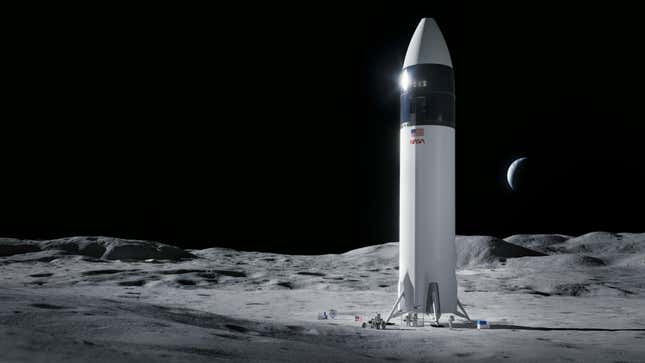
NASA has suspended SpaceX’s work on its $2.9 billion lunar lander to return astronauts to the moon due to protests filed Blue Origin and Dynetics, the companies that the space agency didn’t choose to build its lunar lander.
On Friday, NASA spokesperson Monica Witt announced issued a brief statement announcing the pause and said it would remain until the Government Accountability Office resolved the complaints associated to the procurement. The GAO has until Aug. 4, at the latest, to make a decision over the challenges presented by Blue Origin, founded by Amazon CEO Jeff Bezos, and defense contractor Dynetics.
“On April 26, NASA was notified that Blue Origin Federation and Dynetics filed protests challenging the Option A human landing system selection with the U.S. Government Accountability Office (GAO),” Witt said in a statement to Gizmodo. “Pursuant to the GAO protests, NASA instructed SpaceX that progress on the HLS contract has been suspended until GAO resolves all outstanding litigation related to this procurement. NASA cannot provide further comment due to the pending litigation.”
A request for comment from SpaceX on Saturday was also not immediately returned. We’ll update this blog if we hear back.
NASA’s ordered pause on SpaceX’s work on the lunar lander, for which it will use its Starship launch system, means that SpaceX won’t immediately receive the first installment of the $2.9 billion award, the Verge reported. The company also won’t begin the initial talks with NASA that are customary at the commencement of a major contract.
Nonetheless, considering that SpaceX plans to use Starship to carry cargo and crew to Earth’s orbit, the Moon, and Mars, the company is likely to continue development on Starship, the Verge noted. Earlier this week, the Federal Aviation Administration said it had authorized the next three launches of the Starship prototype. Several Starship prototypes have carried out high-altitude flights, but to date all flights have ended in explosions.
In its complaint filed on Monday, Blue Origin alleged that NASA had “executed a flawed acquisition for the Human Landing System program and moved the goalposts at the last minute.” First, the company states that NASA indicated its intention to make two awards for its lunar lander system but changed its mind due to “perceived shortfalls” in its current and future budget. Going with a sole provider threatens to eliminate competition in this area, Blue Origin claims.
That’s not all though. Among other perceived slights, Blue Origin is also crying foul over the price of the lunar lander. The company gave NASA a price of $5.99 billion, more than double SpaceX’s price. However, the company states that NASA allowed SpaceX to revise its price but did not give the same opportunity to Blue Origin and Dynetics.
Dynetics, which also filed its complaint on Monday, argues that NASA should have revised its approach to the lunar lander or withdrawn the solicitation once it knew it didn’t have funding to support two companies, SpaceNews reported. Instead, NASA decided to go with “the most anti-competitive and high-risk option available.”
NASA’s decision essentially makes SpaceX its lunar lander provider for the foreseeable future, Dynetics affirmed, according to SpaceNews. The company also criticized NASA’s analysis of SpaceX’s technical approach.
“NASA failed to consider the risks inherent in SpaceX’s technical approach and, more specifically, information too close at hand for NASA to ignore—i.e., that four SpaceX Starships have exploded at various stages of their tests flights in recent months,” Dynetics said in the complaint. “NASA has given SpaceX a pass on its demonstrable lack of such systems engineering.”
The company does have a point there. Blue Origin seemed to be the leader in the bidding process, and its choice for a lunar lander was considered sensitive and safe. SpaceX has to prove that its Starship approach, which includes refueling a rocket in space and landing a rocket vertically on the lunar surface, among others, is possible. Neither of these things has ever been done before. It also has to keep its Starships from exploding.
NASA’s current plan is to send two astronauts—a man and woman—to the lunar surface in 2024.
Update 5/3/2021, 1:04 p.m. ET: This post has been updated a comment from NASA.